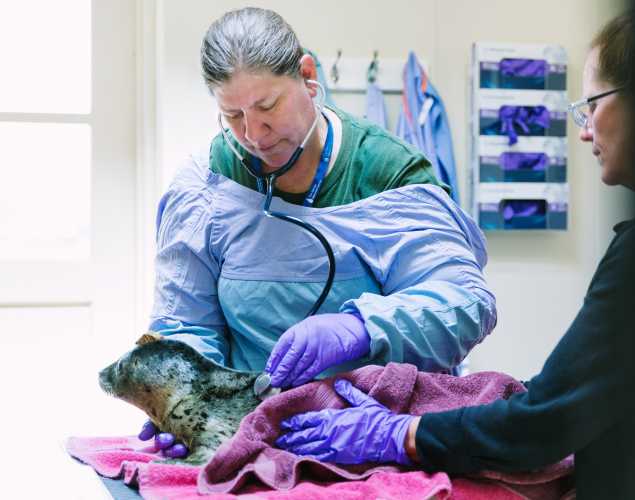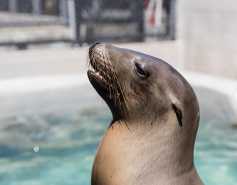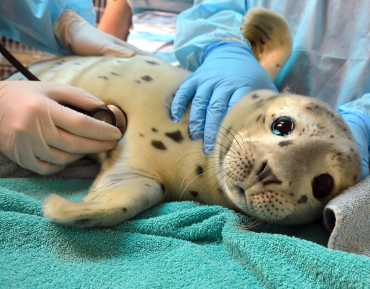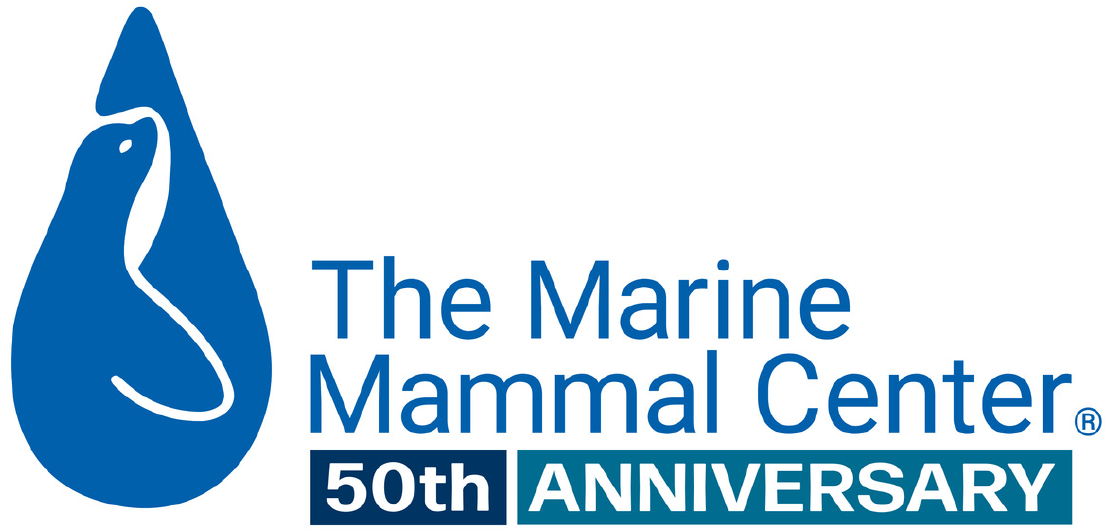
Marine Science Careers: Meet Marine Mammal Veterinarian Dr. Cara Field
- Marine science careers
Ever wondered how to become a marine mammal veterinarian? Learn what it takes and find out how Dr. Cara Field uses her role as a teacher to help protect our ocean for future generations.
Dr. Cara Field is so much more than The Marine Mammal Center’s medical director. She is also one of the many teachers who makes the Center a world-class teaching hospital.
As a critical first responder for marine mammals, The Marine Mammal Center provides a unique opportunity to learn from sick and injured animals, in order to better protect their ocean home.
We also host hundreds of students and professionals every year who come to study with our experts. Our scientists and veterinarians teach these visitors the skills needed to respond to and care for the increasing number of distressed marine mammals around the world.
Cara is one of those rare people who knew exactly what she wanted to do with her life at a very young age. As a small child, she could be found turning disrupted sea stars right side up and saving other tide-pool dwellers near her home in Santa Cruz, California. For as long as she can remember, Cara wanted to help animals.
As a young adult, Cara joined her science- and animal-loving peers in both graduate and veterinary school. It was during her graduate studies of deep-diving elephant seals that she discovered the Center and started volunteering every Sunday to help feed and care for the animals.
Throughout her seemingly endless years of higher education, Cara interned at several aquariums and stranding organizations around the country, but she always made her way back to the Center. Why? Because her dream was to make the Center’s unique combination of medicine, research and teaching a central part of her life.
When Cara first began volunteering, the Center was limited to fewer pens and smaller pools, and buildings were primarily portable storage units. But even then, she recalls her experience as incredible. Seeing just how many people, from all sorts of backgrounds, could be trained on-site and perform the hands-on work simply blew her away.
What I love about The Marine Mammal Center is that you can see the science, the medicine and the teaching all rolled up into this incredible effort driven by all these people.
Those seven years Cara spent volunteering at the Center shaped her background in marine mammal medicine. The experience helped her develop a much deeper understanding of the importance of veterinary science and its role in the health of our ocean and the ecosystem as a whole.
The Center rescues and rehabilitates hundreds of marine mammals each year, which puts Cara in the perfect position to use what she learns from our patients to better inform solutions that will help protect the ocean environment. Marine mammals are ecosystem indicators meaning that by understanding the challenges they are facing out in the ocean, we can better understand the threats facing the marine environment as a whole.
In veterinary school, the bigger picture isn’t always fully addressed as most programs are heavily focused on medicine. Cara believes that a key factor in conservation is studying animals as they interact with their environment.
If we don’t look at the bigger picture, we miss what contributes to an animal’s suffering in the first place.
See Dr. Cara Field's Recent Publications
{"image":"\/Animals\/Patients\/California sea lions\/cropped-images\/csl-by-bill-hunnewell-c-the-marine-mammal-center-3-2-318-2819-2252-1600897445.jpg","alt":"California sea lion","title":"Establishing Dosing Requirements for an Anti-Fungal Medication in Young Sea Lions","link_url":"https:\/\/www.marinemammalcenter.org\/publications\/establishing-dosing-requirements-for-an-anti-fungal-medication-in-young-sea-lions","label":"Research Paper","type":"publication"}

Establishing Dosing Requirements for an Anti-Fungal Medication in Young Sea Lions
Read More{"image":"\/Animals\/Patients\/Elephant seals\/2018\/es-seafoam-by-bill-hunnewell-c-the-marine-mammal-center-1.jpg","alt":"northern elephant seal with mouth open, showing teeth","title":"Treatment of Canine Tooth Fractures in the Northern Elephant Seal: Three Cases","link_url":"https:\/\/www.marinemammalcenter.org\/publications\/treatment-of-canine-tooth-fractures-in-the-northern-elephant-seal-three-cases","label":"Research Paper","type":"publication"}

Treatment of Canine Tooth Fractures in the Northern Elephant Seal: Three Cases
Read More{"image":"\/Animals\/Patients\/Harbor seals\/hs-by-bill-hunnewell-c-the-marine-mammal-center-6.jpg","alt":"a group of harbor seals in the water","title":"Evaluating Whether Lactate Levels in the Blood Can Predict Recovery","link_url":"https:\/\/www.marinemammalcenter.org\/publications\/evaluating-whether-lactate-levels-in-the-blood-can-predict-recovery","label":"Research Paper","type":"publication"}

{"image":"\/Animals\/Wild\/Sea otter\/sea-otter-photo-c-brian-simuro.jpeg","alt":"sea otter in a seagrass bed","title":"New Brucella Bacterial Infection in Southern Sea Otters","link_url":"https:\/\/www.marinemammalcenter.org\/publications\/new-brucella-bacterial-infection-in-southern-sea-otters","label":"Research Paper","type":"publication"}

As the world’s largest marine mammal hospital, the Center cares for a wide variety of animal species with differing ailments, giving visiting students a rich environment for learning about ocean health issues and conservation on a broad scale. This growing network of marine science professionals can in turn use and share their newfound knowledge to protect the ocean for the future.
Cara encourages her students to cater their experience at the Center to fit their interests and needs so that when they return home, they are prepared to tackle the challenges that lay ahead.
For example, María Soledad “Sole” Sarzosa Moreta, one of our recent International Veterinary Fellows, is a veterinarian from Ecuador. There she investigates the health of Galápagos sea lions. During her time at the Center, Sole gained valuable experience in medicine, microbiology, patient care, research and more under the expert guidance of Cara and other staff. Sole returned to Ecuador with new skills to further develop response and health evaluation protocols for the endangered Galápagos sea lion.
Many of our other program alumni have used what they’ve learned here as a platform for their own careers. They’ve gone on to manage large marine mammal response networks, conduct research in Antarctica and coordinate marine mammal disentanglement projects. Veterinarians in many countries have few opportunities to work with stranded marine mammals, and our unique International Veterinary Fellowship Program helps equip these veterinarians with the knowledge and skills to build rescue and rehabilitation programs from the ground up.
Watching the ripple effect as our alumni shared their newfound knowledge across the world helped Cara realize that teaching future generations is the foundation of advancing global ocean conservation. With that in mind, Cara recently pursued an additional certification to bolster her own teaching efforts.
The American College of Zoological Medicine is the highest authority in the field of veterinary medicine for wildlife and zoological species. After years of arduous preparation, Cara passed a multi-day exam that earned her the status of Diplomate with specialization in Aquatic Animal Medicine – a highly respected certification that only a few dozen other people in the nation have acquired
When asked what a typical day is like for her, Cara just tips her head back and laughs. Yes, in any given day she may perform patient exams, teach a group of enthusiastic students and review data collected for a research project. But there is no “typical,” and that’s what she loves about it. She takes pride in the stories she’s helped shape as her alumni share their knowledge and skills saving marine mammals and advancing ocean conservation around the world.
You Too Can Make a Difference
People like you make it possible for more than 100 visiting students and veterinary professionals to take advantage of the incredible learning opportunities at The Marine Mammal Center every year. Your gift today will help ensure our teaching hospital continues to grow, advancing ocean conservation on a global scale.
Do You Want to Be a Veterinarian?
What kind of education is needed?
What kind of education is needed?
If you’re in high school, you should take college-prep courses that focus on sciences like anatomy, physiology, chemistry and biology. As an undergraduate college student, pursuing a degree that will strengthen your scientific knowledge and taking prerequisite classes required for the veterinary school you’re interested in will likely bolster your candidacy. Common majors are zoology, biology, animal science, physiology and many more.
Similar to medical school, acceptance into an accredited Veterinary Medicine program is very competitive, and the first stage of application review often puts grades as the most important factor. With that in mind, it’s recommended that you challenge yourself to earn an excellent and well-rounded academic record during your undergraduate studies. Additional higher education such as a master’s degree can also strengthen your application to veterinary school.
Once you’ve attained your doctorate degree, you must pass the North American Veterinary Licensing Exam (NAVLE) to practice within the United States, as well as any additional state-specific exams. Additional specialty training in many fields, including zoological and wildlife medicine, is available through internships, fellowships and residency programs.
What kind of real-world experience is needed?
What kind of real-world experience is needed?
Experience with animals is a requirement for acceptance to veterinary school, and a wide variety of experiences are possible. There are many opportunities to work with animals while helping the community. Some of which include volunteering at animal care centers, such as animal shelters and wildlife rehabilitation centers, and at veterinary clinics or a veterinary teaching hospital like The Marine Mammal Center. If you’re in high school, check out programs like our Youth Crew to gain comprehensive experience.
During your studies, you’ll likely meet lots of practicing veterinarians that you can connect with and shadow in order to gain the hands-on experience needed. Also, there are often internships available through different organizations, such as zoological institutions, research centers and nonprofit centers. Many of these opportunities may be advertised on your college campus, but also through dedicated list serves and professional organizations. An example of a marine mammal-focused professional organization is the Society for Marine Mammology and the MARMAM email list.
What kind of careers are available?
What kind of careers are available?
There’s a wide variety of careers available to veterinarians, including private practice with pets, wildlife medicine, large animal – such as livestock and equine – medicine, research, teaching, policy – both private and government – and public health. Many veterinarians, like Dr. Cara Field, combine some of these areas throughout their careers.
See More Marine Science Careers
{"image":"\/People\/Action\/Education\/cropped-images\/laura-gill-info-desk-by-elena-graham-c-the-marine-mammal-center-0-0-4916-3840-1616526365.jpg","alt":"Laura Gill talks with a visitor at The Marine Mammal Center","title":"Marine Science Careers: Meet Environmental Educator Laura Gill","link_url":"https:\/\/www.marinemammalcenter.org\/news\/marine-science-careers-meet-environmental-educator-laura-gill","label":"News Update","date":"2021-03-19 02:00:00","type":"news"}

{"image":"\/People\/Action\/Research\/cropped-images\/lab-carlos-rios-by-elena-graham-c-the-marine-mammal-center-0-0-635-496-1601755747.jpg","alt":"Carlos Rios holding a test tube","title":"Marine Science Careers: Meet Clinical Lab Scientist Carlos Rios","link_url":"https:\/\/www.marinemammalcenter.org\/news\/marine-science-careers-meet-clinical-lab-scientist-carlos-rios","label":"News Update","date":"2021-09-08 02:00:00","type":"news"}

Marine Science Careers: Meet Clinical Lab Scientist Carlos Rios
September 8, 2021
Read MoreYes, I want to save a life!

Yes, I want to save a life!
You’ll be giving sick and injured animals the best possible care at the Center’s state-of-the-art hospital. With your gift today, you are giving a patient a second chance at life in the wild.
See Our Latest News
{"image":"\/Animals\/Patients\/Hawaiian monk seals\/2025\/cropped-images\/d-ru28release-exam-at-ke-kai-ola111025photo-by-giancarlo-rulli-c-the-marine-mammal-center-noaa-permit-24359-0-0-1270-992-1764620886.jpg","alt":"","title":"Bird Flu Vaccine Trial Offers Hope for Protecting Hawaiian Monk Seals","link_url":"https:\/\/www.marinemammalcenter.org\/news\/bird-flu-vaccine-trial-may-offer-hope-for-protecting-hawaiian-monk-seals","label":"News Update","date":"2025-12-01 08:13:00"}

Bird Flu Vaccine Trial Offers Hope for Protecting Hawaiian Monk Seals
December 1, 2025
Read More{"image":"\/Animals\/Patients\/Hawaiian monk seals\/2021\/hms-pp08-by-sheila-latta-c-the-marine-mammal-center-noaa-permit-18786.jpg","alt":"Hawaiian monk seal","title":"The New York Times: Inside the Bird-Flu Vaccine Trial for Monk Seals","link_url":"https:\/\/www.marinemammalcenter.org\/news\/the-new-york-times-inside-the-bird-flu-vaccine-trial-for-monk-seals","label":"In the News","date":"2025-12-01 01:00:00"}

The New York Times: Inside the Bird-Flu Vaccine Trial for Monk Seals
December 1, 2025
Read More{"image":"\/Animals\/Wild\/Sea otter\/so-wild-morro-bayphoto-c-brian-simuro-20.jpeg","alt":"Sea otter and pup","title":"Watch a Sea Otter Pup Reunite With Its Mother","link_url":"https:\/\/www.marinemammalcenter.org\/news\/watch-sea-otter-pup-reunite-with-its-mother","label":"News Update","date":"2025-11-14 10:35:41"}

{"image":"\/Animals\/Wild\/Sea otter\/sea-otter-photo-c-brian-simuro.jpeg","alt":"Sea otter","title":"AP News: Baby sea otter is reunited with mother in central California after dramatic rescue","link_url":"https:\/\/www.marinemammalcenter.org\/news\/ap-news-baby-sea-otter-is-reunited-with-mother-in-central-california-after-dramatic-rescue","label":"In the News","date":"2025-11-14 09:46:34"}

AP News: Baby sea otter is reunited with mother in central California after dramatic rescue
November 14, 2025
Read MoreCara Field
